Though Tim Belcher is not really a Frankoma “Old-Timer,” this “New-Timer” made a great find, and he wants to share his experience with us.
“I recently purchased a silver overlaid Frankoma sugar bowl from the early 1940’s. I had never seen this before and learned that some pieces were sent to a New York firm that added the overlay and then marketed the pieces through their outlets.”
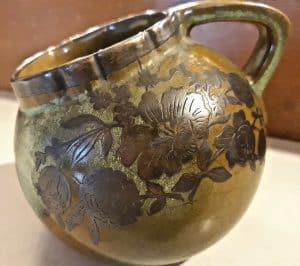 “When I first saw this bowl, I didn’t buy it. It was with a few other Frankoma pieces without the silver. I took a picture and later did some research, but since I didn’t recognize it as silver, I couldn’t find anything about it. It intrigued me, so I went back a few days later to get it. The other, more common items had been sold.”
“When I first saw this bowl, I didn’t buy it. It was with a few other Frankoma pieces without the silver. I took a picture and later did some research, but since I didn’t recognize it as silver, I couldn’t find anything about it. It intrigued me, so I went back a few days later to get it. The other, more common items had been sold.”
During the 1940’s Frankoma supplied various vases and bowls to American Silver Works of New York. These pieces were purchased from Frankoma and resold through their New York company after applying the silver design. American Silver Works also applied silver to other potteries, including Haeger.
“The silver was so tarnished, I thought the overlay was a decal of some sort. I did some digging on the American Silver Works of New York but couldn’t find any reference to them except through Frankoma mentions.”
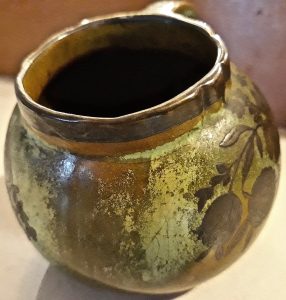 These items are rare and highly sought after by collectors and usually bring anywhere from a few hundred dollars upwards to $1000.00. They are sometimes left out of Frankoma references, because they were never actually sold by Frankoma with the applied silver, and some “purists” don’t consider them any more collectible than craft pieces. This piece is an extraordinarily beautiful example of the art of silver overlay.
These items are rare and highly sought after by collectors and usually bring anywhere from a few hundred dollars upwards to $1000.00. They are sometimes left out of Frankoma references, because they were never actually sold by Frankoma with the applied silver, and some “purists” don’t consider them any more collectible than craft pieces. This piece is an extraordinarily beautiful example of the art of silver overlay.
Tim noticed that in the McBain Reference and Price Guide, the sugar bowl is listed as 87B, but his piece is stamped 87A. He wondered if it was common to mis-stamp pieces. While it was not a common practice, some have been found mis-marked, especially pieces in the ball pattern batter set, which consisted of a batter, syrup and cream pitchers and the ball sugar bowl. Information with pictures can be found in the McBain Frankoma Book, which is also available free from the Website.
“I am not a Frankoma collector but, having lived in Tulsa for a decade and marrying a girl who was raised there, we have several pieces. Now living in western Kentucky, I’m surprised when I occasionally come across it. I would consider selling this piece if the price is right. I collect 19th-century embossed bottles and would consider trades, too. I didn’t realize how collectible Frankoma has become, so I’ll pay more attention in the future when I see some. The Reference will certainly help with valuations.”
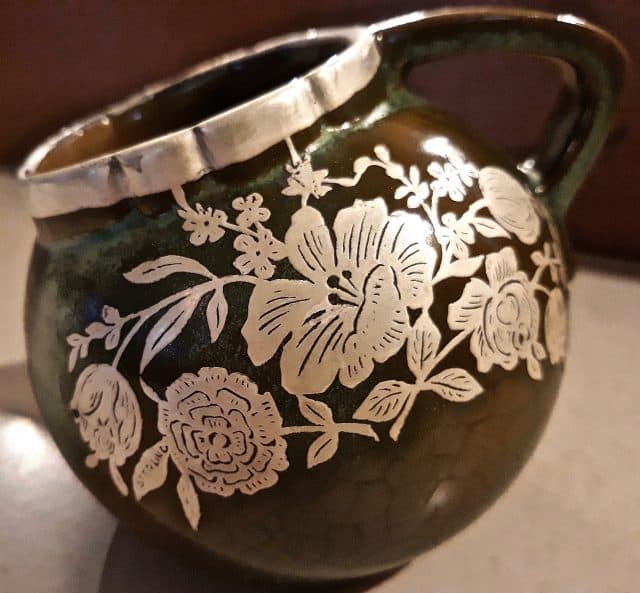

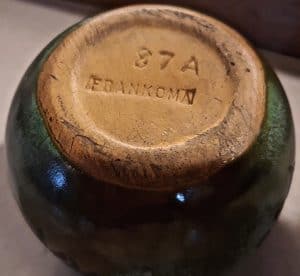
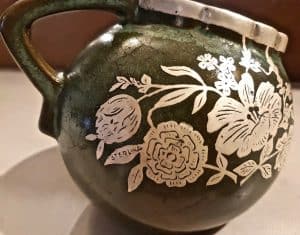








I have a question–I recall that a person can tell where pieces were made in Oklahoma by the color of the clay, bottom of piece. There is a large set o Green dishes for sale in a shop where I volunteer. The bottom is more red than brown, some have the glaze on some bottoms. How would I determine how much it is worth? It is a pretty common green glaze. I think there are numbers on bottom also. I also have a set of the wagon design that was my mothers, wondering what it is worth. I enjoy receiving these emails. Thanks
Thank You Kenneth Wickham for your very informative and wonderful articles on Frankoma Pottery ! Always read and Gain so much from Frankoma collectors.org!